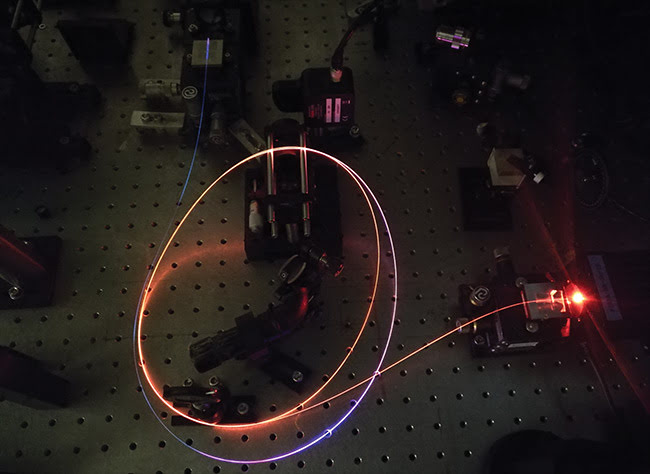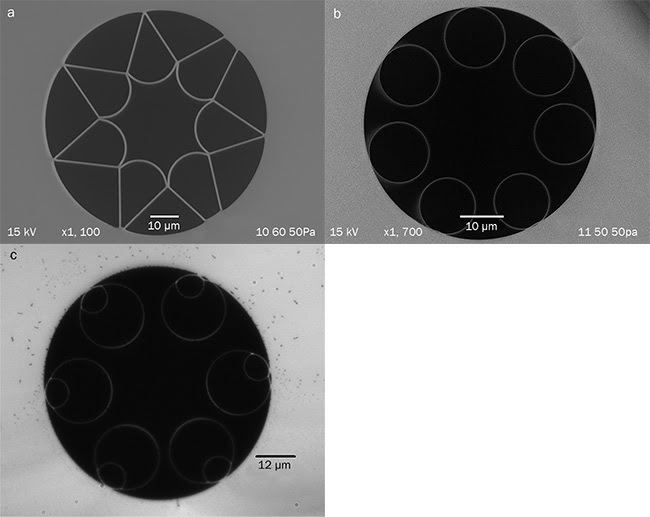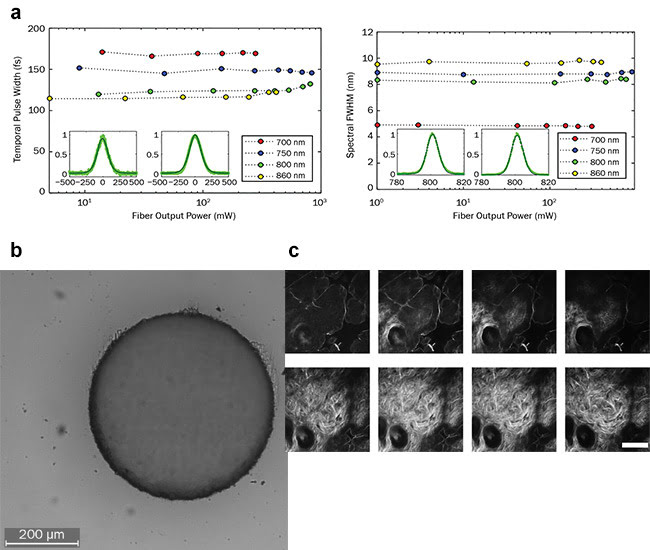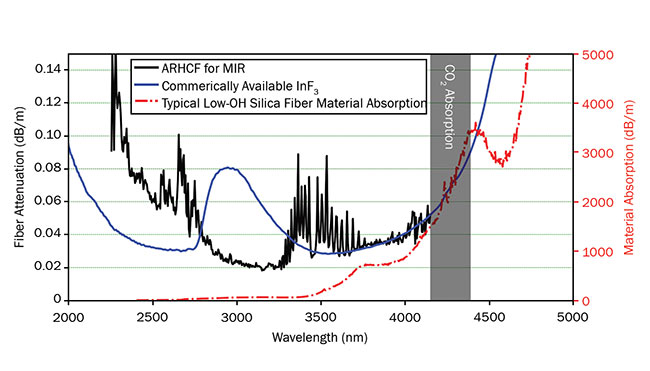As demands on optical fiber performance increase, researchers show that hollow-core fibers may prove useful in the MIR and UV, and for delivering ultrashort pulses in the visible and near-IR.
JONATHAN KNIGHT, UNIVERSITY OF BATH; DUNCAN HAND, HERIOT-WATT UNIVERSITY; AND FEI YU, CHINESE ACADEMY OF SCIENCES
Conventional optical fibers are fabulously successful, but they have profound limitations. These include a finite spectral transparency, susceptibility to optical damage, dispersion — which restricts the ability to deliver short and ultrashort pulses — and nonlinear optical response.
Such limitations are fundamental to conventional optical fibers because the light travels through a solid or a liquid material. In most conventional fibers, fused silica is the material that forms the glassy core of the fiber. Researchers are now demonstrating that an alternative optical fiber technology, based on the use of silica fibers but with hollow cores and using different optical physics, can substantially outperform standard fiber designs for numerous applications.

Figure 1. Antiresonant hollow-core fiber is delivering 300-fs ultrafast laser pulses with average power up to 1 W. The glowing of fiber comes from the supercontinuum generated by laser pump in the air of the hollow core. Courtesy of Heriot-Watt University.
In some applications — for example, for data transmission in terrestrial optical telecommunications systems, or as gain fibers for short-pulse fiber lasers — conventional fibers will remain preeminent. But numerous emerging applications are being enabled by alternative fiber designs. These include delivery of powerful picosecond/subpicosecond pulses throughout the visible and near-IR, damage-free delivery of laser light in the UV, and low-loss transmission into the mid-IR — far beyond the usable spectral window of conventional fibers. With these and other applications, this alternative hollow-core technology is earning a place in the toolkit of photonic components for the future (Figure 1).
Trapping light in a hollow core
The lure of hollow-core optical fibers is not new. Inner-surface-coated fibers have long been known to be effective for certain applications1, but they are hard to manufacture in long lengths and typically transmit light through multiple spatial modes. Fibers based on the use of a photonic bandgap cladding were developed around the turn of the century and represented a step change improvement in performance characteristics.

Figure 2. Cross sections of functional designs of antiresonant hollow-core fibers developed at the University of Bath. Dark regions are air and lighter regions are fused silica. Courtesy of University of Bath.
Since around 2011, a far simpler family of structures has been shown to represent a dramatic advancement2, while being much easier to produce. Like photonic bandgap fibers, these new designs rely on the presence of air holes running down the fiber length to control the flow of light. They trap light in an optical mode of the hollow core by controlling the microstructure and hence the other optical modes in the immediate vicinity of the core. The fibers work by surrounding the central hole with a wall of glass that is antiresonant, enhancing the reflection of light back into the core. These fibers are often referred to as antiresonant hollow-core fibers.
Other elements of the design are also important, such as the shape of the core wall and the number and size of the surrounding air holes. In contrast to photonic bandgap fibers, antiresonant fibers do not require a 2D periodic array of wavelength-scale air holes in the cladding, making them significantly easier and quicker to produce. They also have relatively large core diameters (typically around 30× the wavelength) compared to either conventional fibers or photonic bandgap fibers, which provides several advantages in performance characteristics (Figure 2).

Figure 3. Characteristics of Ti:sapphire femtosecond pulse delivered through a 4-m antiresonant hollow-core fiber. FWHM: full width half maximum (a). Hollow-core fiber delivered picosecond laser pulses can be used to machine-fuse silica (the same material as the fiber). Scale bar is 200 µm (b). Multiphoton autofluorescence images of two planes of the epidermis of an ex vivo mouse skin sample excited by fiber-delivered ultrashort pulses at different wavelengths (left to right: 740, 780, 820, and 860 nm). Scale bar is 50 µm. (c). Figures a and c reproduced from reference 4 under Creative Commons. Figure b courtesy of Heriot-Watt University.
Ultrashort-pulse delivery
In manufacturing, in biomedicine, and in other fields, ultrashort-pulse fiber lasers have become inexpensive and reliable tools. However, conventional single-mode optical fibers are not able to deliver the ultrashort pulses these lasers produce, often restricting the deployment of these lasers and making them uncompetitive. Conventional fibers literally “fail to deliver” due to their optical nonlinear response and their dispersion. Taken together, these two effects rapidly lengthen ultrashort optical pulses as they travel through even very short lengths of fiber, reducing the peak intensity and making the pulses ineffective for most applications.
Antiresonant hollow-core fibers address both of these unwanted effects3,4. The nonlinear response of the fibers is reduced by many orders of magnitude — first, because the intrinsic Kerr nonlinearity of air is around 1000× less than that of silica glass, and second, because the larger core size reduces the intensity of light in the core. This same combination of large core size and reduced material contribution simultaneously reduces the fiber dispersion to far below that found in standard single-mode fibers. As a result, the fibers can transmit even powerful ultrashort pulses, with almost no pulse distortion (Figure 3a)4.
Unlike conventional fibers, where the fiber dispersion is strongly dependent on the operating wavelength, antiresonant fibers exhibit low dispersion across a broad spectral range and have been used successfully for ultrashort-pulse delivery at a number of important wavelengths, including 1550, 1060, and 532 nm. This capability will enable numerous applications — for example, delivery of pulsed light to a scanning head for machining glass (Figure 3b), or simplifying coupling light from a laser source into a multiphoton microscope (Figure 3c).
Silica-based fibers for the MIR
Silica-based fibers are fantastically
transparent, but only over a finite spectral range. For wavelengths longer than around 2500 nm, in the MIR, silica becomes absorbing, and optical fibers usually need to be made of different glasses that can transmit these longer wavelengths. Such fibers are available, but they do have drawbacks when compared to the silica fibers that are used for shorter wavelengths5. Nonsilica or soft glass fibers are not as strong or as easy to work with, nor are they as transparent. They also tend to have high nonlinearity and dispersion, severely limiting their use for short-pulse delivery.

Figure 4. Comparison between low-loss, single-mode antiresonant hollow-core fiber (ARHCF) and
commercial multimode solid-core InF3 fiber (see reference 5) in the MIR. The diameters of the hollow-core and InF3 fibers are 106 and 100 μm, respectively. The attenuation of the hollow-core fiber was measured by cutback from 226 to 46 m. The sharp cutoff of transmission around 4.2 μm is due to a strong atmospheric CO2 absorption line. The red dashed line is the measured material absorption of F300 Heraeus fused-silica glass (right axis). The absorption peaks around 3.5 μm are from gaseous HCl (hydrogen chloride) molecules present in the fiber core, which can be removed by purging. OH: hydroxyl ion. Courtesy of University of Bath.
Despite being made of silica, which becomes absorbing at MIR wavelengths, hollow-core antiresonant fibers can transmit MIR light with low loss because the light travels mainly in the hollow core (Figure 4). Indeed, the optical attenuation of the fibers can be reduced by as much as 20,000× compared to the attenuation of the bulk silica. As a result, in the spectral range between 3 and 5 µm, hollow-core fibers formed from silica have the attractive strength of silica fibers, very low nonlinearity and dispersion, and optical attenuation that is comparable to or better than that of conventional optical fibers formed from IR glass. The combination of these characteristics makes them a potentially valuable technology in this rapidly developing spectral band.
Damage-free fibers for the UV
Conventional optical fibers can suffer from various forms of optically induced damage, but one of the hardest to overcome is caused by the absorption of short-wavelength (UV) photons. The higher photon energy at these short wavelengths causes disruption of the glass matrix at a microscopic scale, leading to the glass suffering from increased absorption. This effect makes it hard to find optical fibers that can stably transmit UV light, although some special fibers with improved characteristics for this spectral window are available. But even these special fibers have limitations and will rapidly degrade when used at short wavelengths and high powers.
Antiresonant hollow-core fibers reduce these problems by several orders of magnitude and offer virtually damage-free transmission6 of UV light, even for short wavelengths and high optical powers. The light travels mostly through the hollow core, which greatly reduces the rate of damage to the glass. And even when the glass is affected, it makes almost no difference to the light trapped in the core, resulting in a minimal reduction of transmission.
Practical challenges and solutions
The obvious questions that arise with such fibers, including bending7 (which ensures that the fibers deliver light single-mode) and fabrication, are largely resolved. Other questions — including optimizing fiber designs, demonstrating the lowest possible attenuation, controlling the polarization state, and ensuring that the fiber end face is protected against ingress of contaminants — remain topics of active investigation for specific applications.
Current research involves using the fibers to develop a new generation of fiber-based optical sources at MIR wavelengths — with high efficiencies and output powers. With clear market advantages, the identification of solutions to the most pressing problems, and a growing number of businesses with the capacity to serve as fiber providers, there is every reason to believe the time has arrived for hollow-core fibers to make a commercial impact.
Meet the authors
Jonathan Knight is a researcher in fiber optics at the University of Bath. He works on the design and fabrication of new fibers and also on their properties and applications; email: [email protected].
Duncan Hand leads research at Heriot-Watt University, where he focuses on applications of high-power lasers. These include use of novel fiber optics for delivery and manipulation of ultrashort-pulsed laser light; email: d.p.hand
@hw.ac.uk.
Fei Yu was formerly with the Department of Physics at the University of Bath, and is now an associate professor at the Shanghai Institute of Optics and Fine Mechanics, Chinese Academy of Sciences; email: [email protected].
References
1. J.A. Harrington (2000). A review of IR transmitting, hollow waveguides. Fiber Integr Opt, Vol. 19, pp. 211-227.
2. A.D. Pryamikov et al. (2011). Demonstration of a waveguide regime for a silica hollow-core microstructured optical fiber with a negative curvature of the core boundary in the spectral region >3.5 μm. Opt Express, Vol. 19, pp. 1441-1448.
3. B. Wedel and M. Funck (2016). Industrial fiber beam delivery system for ultrafast lasers. Laser Tech J, Vol. 13, pp. 42-44.
4. B. Sherlock et al. (2016). Tunable fibre-coupled multiphoton microscopy with a negative curvature fibre. J Biophotonics, Vol. 9, pp. 715-720.
5. Thorlabs Inc. (2014). Mid-infrared fluoride optical fiber, www.thorlabs.de/newgrouppage9.cfm?objectgroup_id=7062.
6. F. Yu et al. (2018). Single-mode solarization-free hollow-core fiber for ultraviolet pulse delivery. Opt Express, Vol. 26, p. 10879.
7. R.M. Carter et al. (2017). Measurement of resonant bend loss in anti-resonant hollow core optical fiber. Opt Express, Vol. 25,
p. 20612.